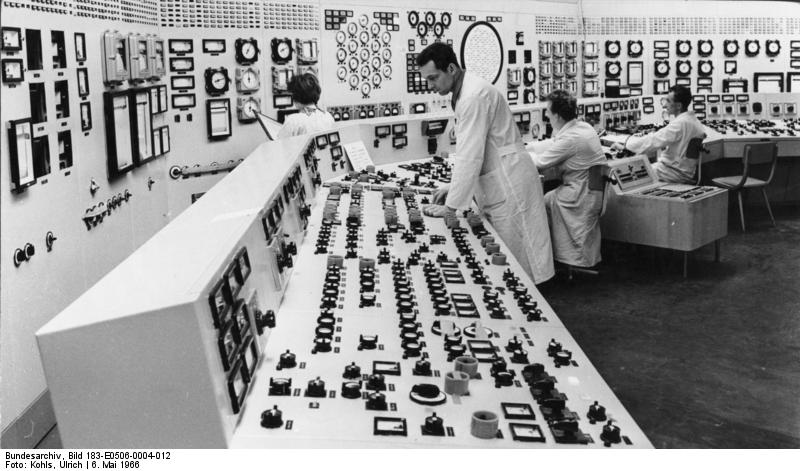Rheinsberg Nuclear Power Plant on:
[Wikipedia]
[Google]
[Amazon]
Rheinsberg 

Rheinsberger Restlaufzeit
''Deutschlandradio'', 2011
Nuclear Power
Nuclear power is the use of nuclear reactions to produce electricity. Nuclear power can be obtained from nuclear fission, nuclear decay and nuclear fusion reactions. Presently, the vast majority of electricity from nuclear power is produced ...
Station was the second nuclear reactor in East Germany
East Germany, officially the German Democratic Republic (GDR; german: Deutsche Demokratische Republik, , DDR, ), was a country that existed from its creation on 7 October 1949 until its dissolution on 3 October 1990. In these years the state ...
after the Rossendorf Research Reactor, and the first nuclear power reactor in East Germany. It was built close to the city of Rheinsberg
Rheinsberg () is a town and a municipality in the Ostprignitz-Ruppin district, in Brandenburg, Germany. It is located on lake and the river Rhin, approximately 20 km north-east of Neuruppin and 75 km north-west of Berlin.
History
F ...
on the Stechlinsee. The power station was one of the first generation of demonstration power reactors.


Start-up
The project commenced in 1956, and construction began January 1, 1960. First criticality followed on March 11, 1966 (the reactor was not pressurised at that time however). Full start-up was on May 9, and commercial power production began on October 11, 1966.Achievement
The singlepressurized water reactor
A pressurized water reactor (PWR) is a type of light-water nuclear reactor. PWRs constitute the large majority of the world's nuclear power plants (with notable exceptions being the UK, Japan and Canada). In a PWR, the primary coolant (water) i ...
was of Soviet design – type VVER-210. Gross power of the station was 70 MWe, but 8 MWe was required to run plant systems, so net output to the grid was 62 MWe. Gross power output was subsequently raised to 75 MWe and then 80 MWe as operating experience increased. Cooling water was taken from the Nehmitzsee and by a special discharge channel was discharged into the Stechlinsee. The plant accumulated 130,000 hours of operating time.
Safety
The worst accident occurring in 1973 at the plant during operation was classified as anINES
Ines or INES may refer to:
People
* Ines (name), a feminine given name, also written as Inés or Inês
* Saint Ines or Agnes (), Roman virgin–martyr
* Eda-Ines Etti (stage name: ''Ines''; born 1981), Estonian singer
Places
* Doña Ines, a vo ...
level-2 event. A tear in tubing in a cooling circuit was noticed quickly and was repaired. In 2011, Deutschlandradio Kultur
Deutschlandfunk Kultur (; abbreviated to ''DLF Kultur'' or ''DKultur'') is a culture-oriented radio station and part of Deutschlandradio, a set of national radio stations in Germany. Initially named ''DeutschlandRadio Berlin'', the station was ren ...
produced a radioplay about this event. ''Rheinsberger Restlaufzeit'' combines a fictional story with original sound clips of the former spokesman of the nuclear power plant as he reconstructs the events of 1973.''Deutschlandradio'', 2011
End of operations and decommissioning
The power plant had been scheduled to be operated for 20 years until 1987; in 1986 (after renovation work) this was extended to 1992. However, on 1 June 1990 the impeding German reunification (which was completed three months later) put an end to operations, when the power station was permanently shut down by the last East-German government due to safety concerns. Since 1995 the plant has been undergoingdecommissioning
Decommissioning is a general term for a formal process to remove something from an active status, and may refer to:
Infrastructure
* Decommissioned offshore
* Decommissioned highway
* Greenfield status of former industrial sites
* Nuclear decommi ...
activities conducted by the company previously operating the plant during its active life (Energiewerke Nord GmbH). Radioactive materials are being moved to a temporary storage facility.
The area is under consideration for either site "greening
Greening is the process of transforming living environments, and also artifacts such as a space, a lifestyle or a brand image, into a more environmentally friendly version (i.e. 'greening your home' or 'greening your office'). The act of green ...
" or conversion into an industrial park
An industrial park (also known as industrial estate, trading estate) is an area zoned and planned for the purpose of industrial development. An industrial park can be thought of as a more "heavyweight" version of a business park or office park ...
once the plant has been dismantled.
Picture on East German Currency
The engraving on the reverse of the 1971 series East German 10 Mark banknote shows a female engineer at the control console of the Rheinsberg plant. The obverse features women's rights advocateClara Zetkin
Clara Zetkin (; ; ''née'' Eißner ; 5 July 1857 – 20 June 1933) was a German Marxist theorist, communist activist, and advocate for women's rights.
Until 1917, she was active in the Social Democratic Party of Germany. She then joined the ...
.
See also
*Repository for radioactive waste Morsleben
The Morsleben Radioactive Waste Repository (German: Endlager für radioaktive Abfälle Morsleben-ERAM) is a deep geological repository for radioactive waste in the Bartensleben rock salt mine in Morsleben, Börde District, in the federal state of ...
;Nuclear plants built in the former East Germany
* Stendal Nuclear Power Plant
*Greifswald Nuclear Power Plant
Greifswald nuclear power station ( German: ''Kernkraftwerk Greifswald'', KKW Greifswald), also known as Lubmin nuclear power station, was the largest nuclear power station in East Germany before closure shortly after the German reunification. ...
References
{{Authority control Former nuclear power stations in Germany East Germany–Soviet Union relations Nuclear power stations using VVER reactors Science and technology in East Germany